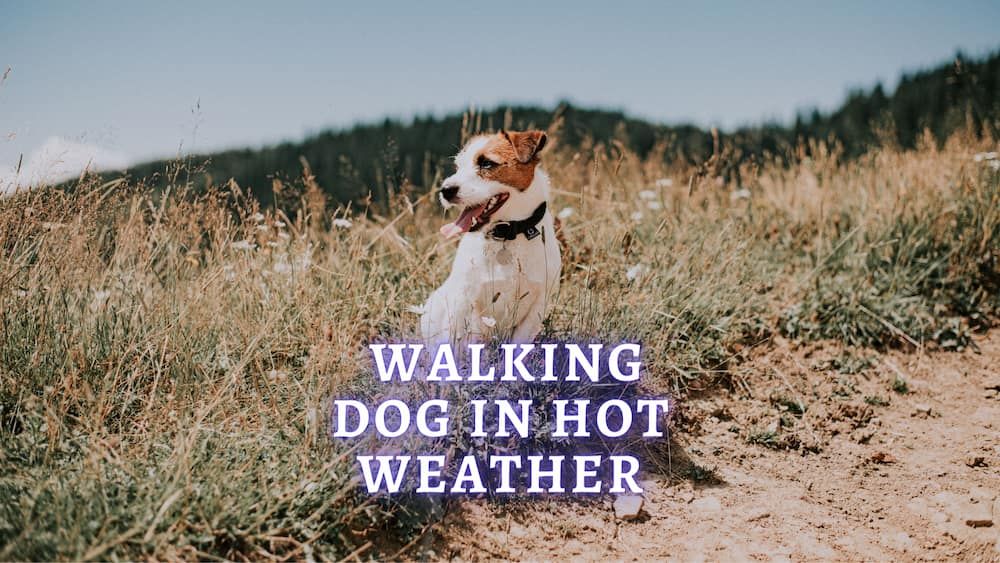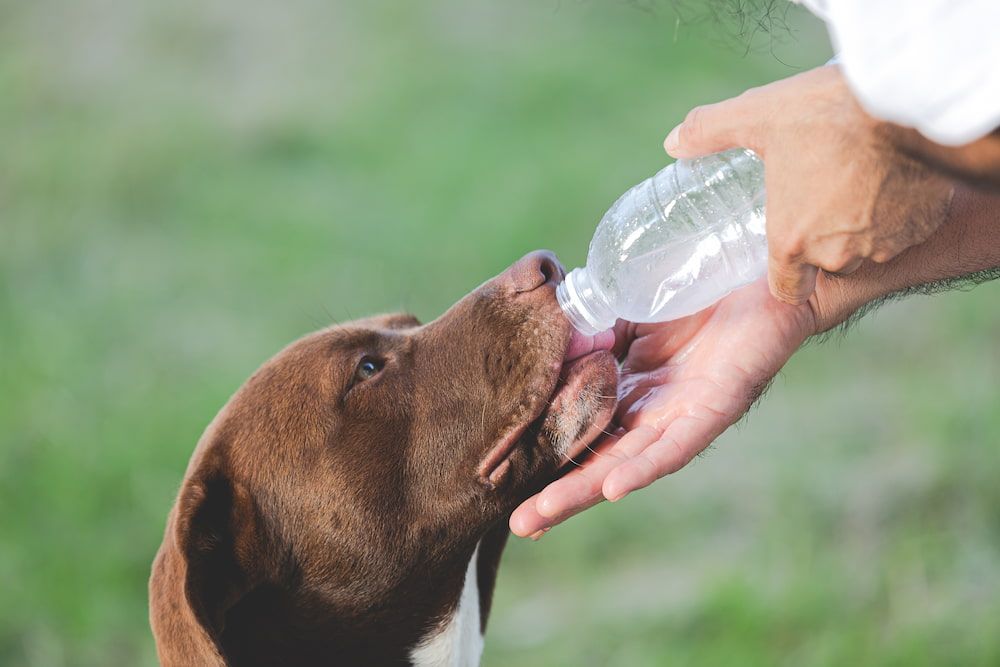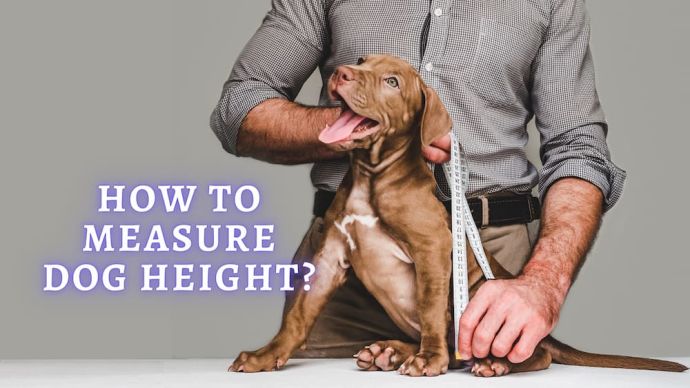When Is It Too Hot To Walk Your Dog? Tips On Walking Your Dog In Hot Weather
Written by:
Author: Seb Jenkins
Seb is a professional SEO writer with a degree in Journalism, he has five years of experience in writing and editing. Seb specializes in topics like dog and cat breeds, aquarium guides, and pet care. He is passionate about educating and entertaining animal owners worldwide. In his spare time, Seb enjoys writing fiction novels.
View all 83 articlesLearn about our editorial process and veterinary review board.
Viewed: 99
Updated on: 06/26/2023
One of the most important duties when owning a dog is ensuring they get enough exercise daily. Regular walks are not only good for physical health but also for a pet’s mental health too. We’ve all seen how fast those tails wag when it’s time for walkies.
However, there are several things you should remember when the hot weather hits. Dogs cannot communicate with you as humans can, so you need to know their limits on their behalf. Recognizing when it is too hot to walk your dog and how long they should be exposed to the sun is essential.
Fortunately, we have compiled an all-you-need-to-know guide to explain just that.
How do you know if it is too hot to walk your dog?
The most important question to ask yourself when heading out on a summer walk is: is it too hot for my dog to walk in this temperature? But how can you be sure of the answer to that?
Experts indicate that a good general rule is 68 degrees Fahrenheit and below is a safe walking temperature for the average pet. Anything from 70F and above is considered risky for dogs as they can develop heatstroke if left exposed for too long. Anything from 77F is considered extremely dangerous.
That being said, the air temperature is not the only thing to consider when walking your dog at hotter times of the year. Humidity, whether there is a breeze, how big your pet is, how old your dog is, whether they have any health risks, ground temperature, and more can all be factors in whether a walk is safe.
Air temperature
As mentioned above, even a leisurely stroll around the block can leave your dog panting and struggling in high heat. This puts them at a very real risk of heatstroke. Have you ever seen pets finding a nice shady spot to lie down in on a hot day? That’s because they are trying to regulate their body temperature, just like we do when sitting in the shade or turning on the AC. Do your best to keep your dog cool.
Surface temperature
It’s not just the air that poses a risk to your dog. Remember where their little paws are walking all day long. If the ground is very hot, then it can pose a risk to the exposed pads on the bottom of your pet’s feet. Did you know that pavement can reach temperatures up to 60 degrees Celsius hotter than the air? Fortunately, there is an easy test you can carry out. Place your bare hand down on the pavement and hold it there for 10 seconds. If it is too hot to touch for that long, it is too hot for your dog to walk on.
Dog breed
The breed of your pet can make a difference when it comes to walking in the heat. Some breeds are naturally better suited to the heat than others, which usually depends on what part of the world they originally came from. Dogs with big, thick coats are obviously not going to be as comfortable in the heat as those with short and thin coats.
Dog age
You should be especially careful with both puppies and older pets when walking in the heat. They are at a higher risk of developing heatstroke. If your dog has any existing health problems, such as trouble with their breathing, then walking on a hot day is also a bad idea.
READ MORE: Signs of Aging in Dogs (Vet Advice)
When is it too hot to walk your dog? What is a safe temperature to walk dogs?
It can be helpful to have a guide that indicates when you should and should not take your dog for a walk. Just remember that every individual pet is different, and there are lots of factors to consider beyond air temperature. Feel free to seek out personalized advice from your vet if you need more information.
- 53 to 59 degrees Fahrenheit – Perfect temperature for walking dogs, with no risk of heatstroke.
- 60 to 66 degrees Fahrenheit – Keep an eye on them, but the risk of heatstroke is low.
- 68 to 73 degrees Fahrenheit – Make it a short and low-energy walk on a lead with you in control.
- 75 to 80 degrees Fahrenheit – Dangerous and high risk of heatstroke. Walk them in the early evenings or late at night when it cools down.
- 82 to 87 degrees Fahrenheit – Too dangerous. Wait for temperatures to drop in the early or late hours before going out on any walk.
- 89 degrees Fahrenheit – Do not take them out under any circumstances.
Tips for walking your dog in hot weather:
There are a number of helpful tips you can follow to keep your four-legged friend as safe as possible in the heat this summer.
Plan ahead
Once the temperatures rise, plan your walks ahead of time. Take a look at the weather report and see when the temperatures are lowest in the day. As long as they drop to a safe temperature, you can head out for a walk. Early mornings and late evenings are often best.
Always check
Never head out on a walk in hot weather without first checking the exact temperature. Sometimes, it may be hotter than you anticipated. Remember, your dog has to walk with their bare feet on the hot pavement, so be aware.
Check the ground
That brings us to our next tip. Always check the ground before heading out on a walk in hotter weather. Place your hand on the ground for ten seconds. If it is too hot for you to hold there, it is too hot for your dog to walk on. Pavements can reach up to 140 degrees Fahrenheit, higher than air temperatures.
Change up your routine
There is nothing wrong with changing things up to accommodate the weather. Find a more shaded walk. Pick a shorter walk. Choose a walk without any steep climbs. Whatever you can do to make things easier and cooler for your dog.
Water on the go
Just like many of us take a bottle of water for a walk on a hot day, you can do the same for your dog. All it takes is a bottle of water and a collapsible water bowl for them to slurp from. Feeding them a raw pet food diet can also increase their moisture consumption.
Keep an eye out
Your dog will not tell you in as many words that they are overheating, but they will show you. Keep an eye out for panting and lethargy when walking in hot weather. Listen to your dog’s body language and recognize when it is time to go home.
Never leave them in the car alone
This is one of the biggest no-nos of pet ownership. Never ever leave them in the car on a hot day. That is a one-way ticket to giving them heatstroke. Keep them as cool as possible during drives on a hot day. And if you need to leave the car then take them with you. Even a few minutes in a hot car can have serious consequences.
READ MORE: How Long Can a Dog Go Without Water?
Best time and place to walk your dog in summer
We all have our favorite dog walking routes, but sometimes you need to change it up in the hotter weather. Try and aim for walks that are near a source of water for your pet to jump into to cool off. Walk them under the shade of trees, if possible. You can also choose the side of the street or the patch of grass that is in the shade. The best time to walk is early morning or late evening during cold weather to keep the dog’s temperature down. Avoid warmer weather during summer walks when the ground temperature is high.
READ MORE: How Much Water Should a Puppy Drink?
Which dogs are more at risk?
All dogs are at risk of heatstroke if made to walk in high temperatures, but there are three groups in particular that are high risk. Puppies are often very hyperactive and want to run around everywhere, which is not a great trait when the sun is beating down. Old-age pets can also struggle more than most in the heat, especially if they have existing health problems. And pregnant dogs should also not be made to exert themselves in the heat. It is also worth noting that dogs with known breathing problems, like bulldogs and pugs, may struggle even more in the heat.
Signs your dog is overheating
There are a number of signs to keep an eye out for that may indicate your dog is overheating.
- Panting or fast breathing.
- Collapsing.
- Convulsing.
- Lots of drooling.
- Gums turn bright blue or red.
- Vomiting.
- Diarrhea.
RELATED: Why Is My Dog Panting At Night?
Conclusion
Make sure you are clued up on how to take care of your dog during the hotter months, and you should be able to reduce the risk of heatstroke and overheating significantly. Feel free to refer back to this guide to refresh your memory too. Happy walking, and let’s keep that dog cool!
 Dog Care Why Does My Dog Poop So Much? Determining A Healthy Poop Schedule For Your Dog
Dog Care Why Does My Dog Poop So Much? Determining A Healthy Poop Schedule For Your Dog - 100
- 0
 Dog Care White Specks In Dog Poop: What Are The Little White Specks In Dog Poop? (Vet Advice)
Dog Care White Specks In Dog Poop: What Are The Little White Specks In Dog Poop? (Vet Advice) - 509
- 0
 Dog Care Dog Bad Breath: Why Does My Dog’s Breath Smell So Bad? (Vet-Approved Advice)
Dog Care Dog Bad Breath: Why Does My Dog’s Breath Smell So Bad? (Vet-Approved Advice) - 46
- 0
 Dog Veterinary Tips Why is my Dog throwing up: Causes and Preventing (Veterinary Advice)
Dog Veterinary Tips Why is my Dog throwing up: Causes and Preventing (Veterinary Advice) - 21360
- 5
 Dog Care My Dog Keeps Scratching His Mouth: Reasons Why Your Dog Scratching Face
Dog Care My Dog Keeps Scratching His Mouth: Reasons Why Your Dog Scratching Face - 16554
- 1
























